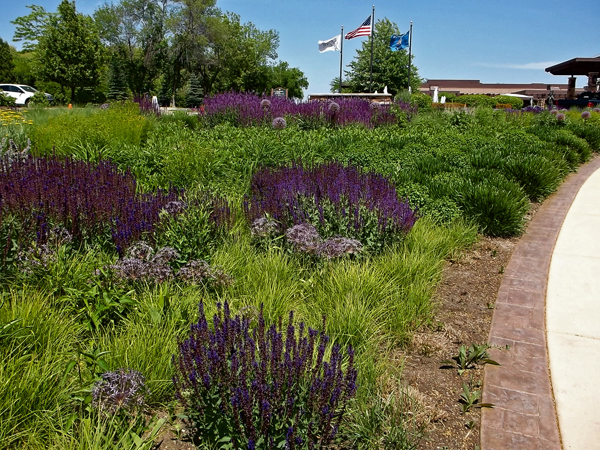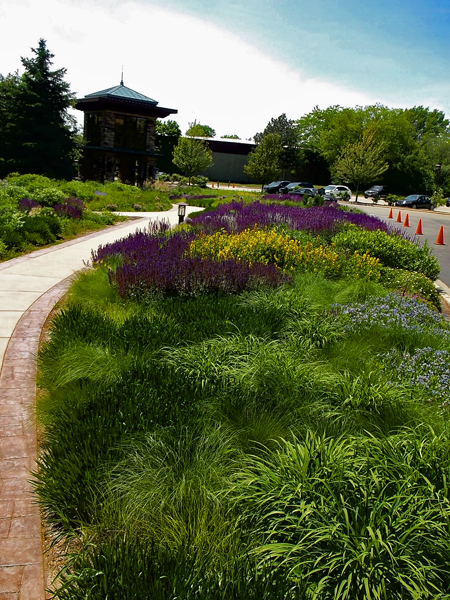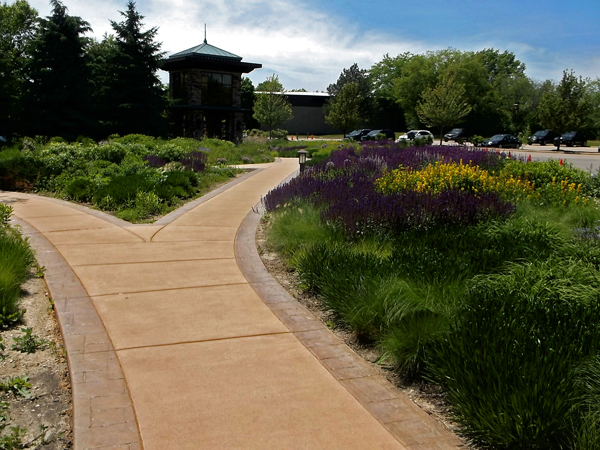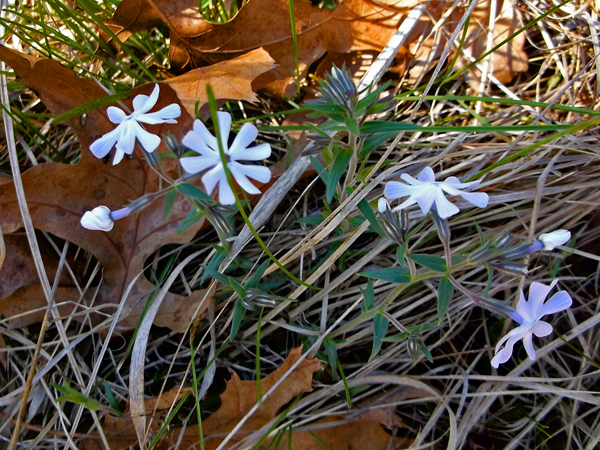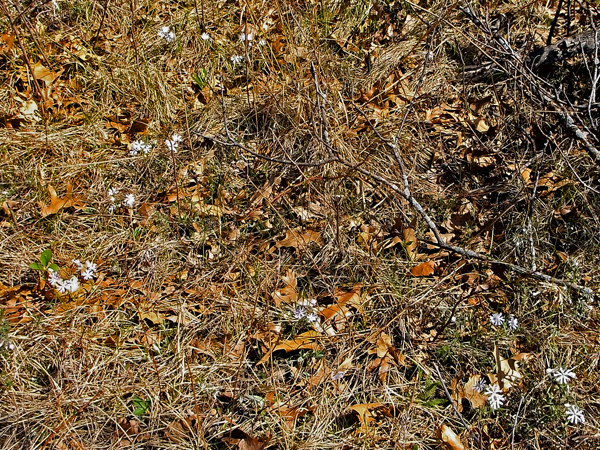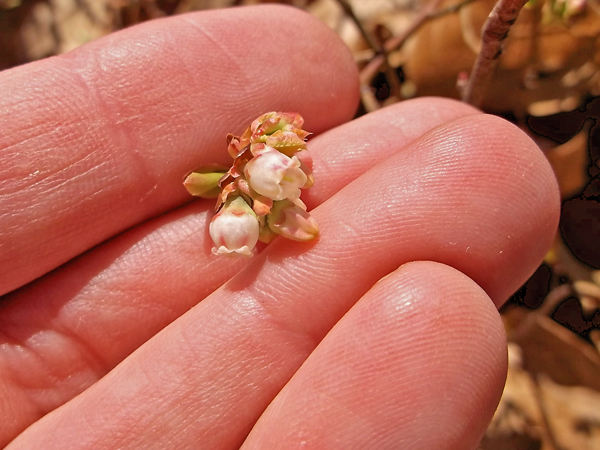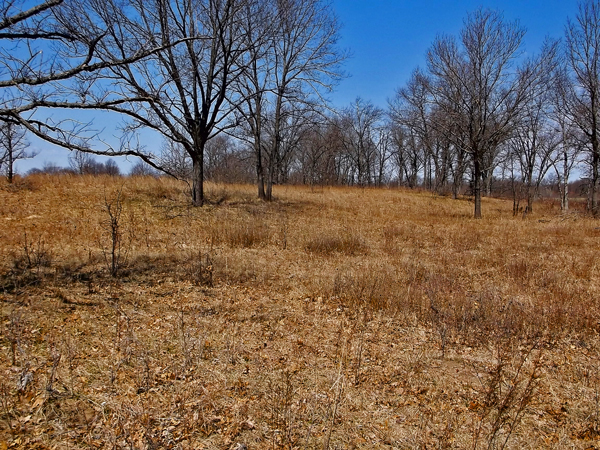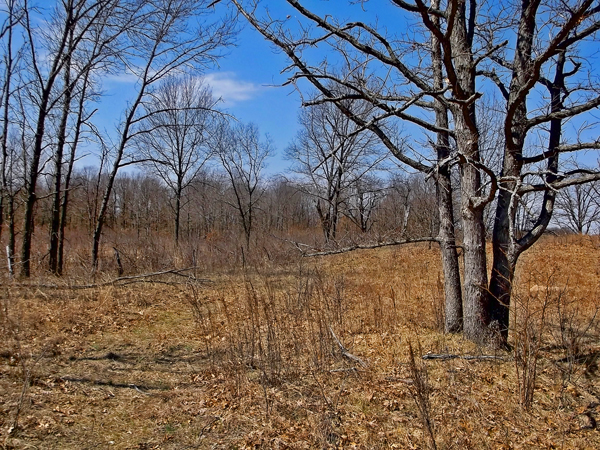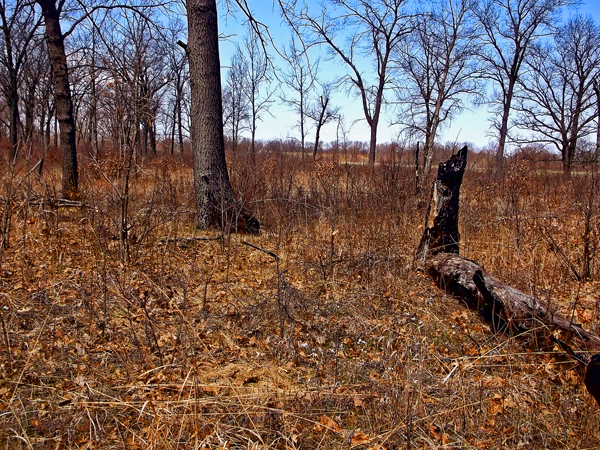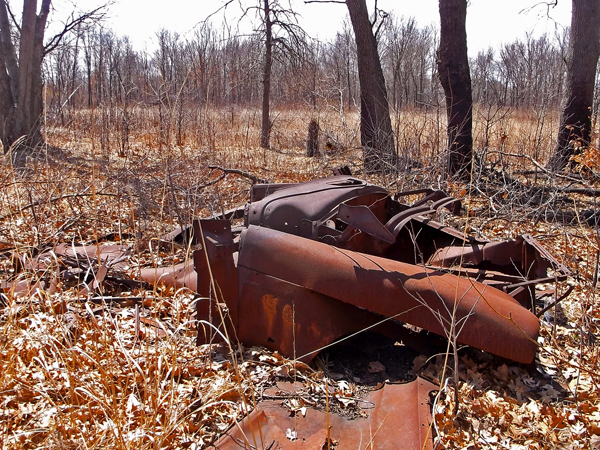
One of the many vignettes at Northwind: a rustic shed with chives and geraniums in flower.
As I drove up to Northwind Perennial Farm, in Burlington, Wisconsin, on Saturday, June 14th, I was met with cars parked all along the street, in front of the nursery. At about the same time, I saw a turn off into a grassy area of the nursery for overflow parking. The nursery was holding an antiques fair that Friday and Saturday – I was more interested in seeing the gardens in early June (I visited last year in late July, which you can read about <Here>). For a little background on Roy and his business partners Steve Coster and Colleen Garrigan there is a good article by Beth Botts which you can find <here>.

The display gardens help the visitor see, literally, what the plants will look like when they are mature specimens – the garden is always changing throughout the season.
As I pulled into the impromptu parking area, I saw Roy walking by himself taking pictures of the all of the cars. As soon as I found a parking space, I grabbed a copy of Roy’s book, “The Know Maintenance Perennial Garden,” from my back seat a walked over to Roy. I introduced myself, mentioned that we have met in the past, and would he mind signing my copy of his book. He smiled, and said “Sure, but I don’t have a pen,” I quickly raised my other hand holding a pen and smiled. We talked for about ten minutes – a very pleasant chat about nothing in particular, but it felt like I was talking with an old friend about that I have known for years.

Geranium ‘Orion’ in the foreground with pink chives and blue salvia behind.
With all of the nearby buzz of the antique sale going on, here I was chatting Roy about his new book, the plants he grows, and life in general – it made the 110 mile journey to his nursery all that more worthwhile.

At the end of our chat, he did take my book and signed it “Roy” along with the note to “Always share the joy of gardening!! Have fun!!” It was the beginning of a very nice visit to Northwind Perennial Farm.

If the plants in the display garden look familiar, then you may also have visited the Lurie Garden in Chicago’s Millennium Park – the garden was designed by Dutch nurseryman Piet Oudolf but the plants were grown by Roy, and many of Piet’s plant choices were inspired by Roy and his love of prairies. Roy has also designed many gardens on his own, including ones at the Art Institute of Chicago (on the northeast and northwest corners), the Shedd Aquarium (that I still need to visit) and one I did visit last weekend at The Grand Geneva Resort, in Lake Geneva, Wisconsin, and many, many more – all based on his “Know Maintenance” approach to garden design, a process of designing communities of plants that work well together, and look good, with a minimum of necessary maintenance – an approach detailed in his latest book: “The Know Maintenance Perennial Garden.”

The sound of water is always a welcome sound in the garden – here, a waterfall is artfully placed in the landscape at Northwind

The blue flowers if Skullcap, Scutellaria incana – a southern Midwest native, are impressive

Skullcap prefers some protection from the afternoon sun and naturally occurs under trees along waterways
The retail yard at Northwind is divided loosely into plants that prefer sun and plants that tolerate or do better in shade, as well as an area with a variety of grasses.
Some of the plants are pulled together as suggestions of good plant combinations and to show how they would look in a garden setting:
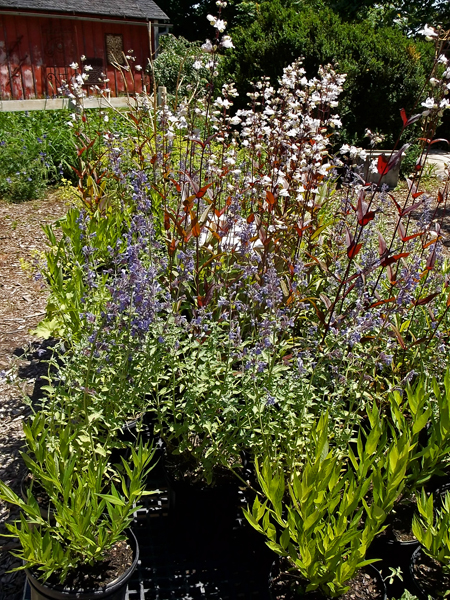
‘Husker Red’ Penstemon, ‘Walkers Low’ Catmint, and ‘Blue Star’ Amsonia
The sun loving plants in the sales area:

This past Sunday The display gardens are helpful in that they show how plants don’t have to be massed in large groupings of one species, next to another large mass of another species, the image below shows a nice alternative, the planting below also demonstrates that leaf texture is as important as flower color – maybe more so. Lesson learned.

Good use of color, on the other hand, is also demonstrated in the gardens at Northwind:

A monochromatic combination of blue Salvia ‘Wesuwe”, along with a hardy geranium and a Purple Allium grown from a bulb.
One plant that caught my eye, that had no showy flowers, was Palm Sedge (Carex muskingumensis), a Midwestern woodland native:

Palm Sedge, the bright green fine textured foliage works well with other plants – in both sun or shade (with good moisture)
It was growing in an open, sunny area, and was as big as a bushel basket. Very dynamic, and showy. I need to divide the ones I have growing my garden, get them out in the sun and also give them more room to develop into specimen plants.

This Palm Sedge was about two feet tall!
Some Plants in Bloom:
The salvias were in bloom, the Lurie Garden is well know for its June blooming “river” of salvia running down its center.

‘Blue Hill’ Salvia, there is also a white version, called ‘Snow Hill’

Salvia ‘Wesuwe’

Kalameris incisa ‘Blue Star’

White ‘Alba’ Dwarf Chives

‘Husker Red’ Penstemon

Yellow Indigo, Baptisia spaerocarpa

Yellow Indigo, three feet tall and wide. Bold!
In one of the shady gardens, I was blown away by the hardy geranium ‘Magnificum,’ aptly named, growing behind a low stone wall constructed by Steve Coster, Roy’s business partner.

The flowers of Geranium ‘Magnificum’ glow in the shade

The color of Geranium ‘Magnificum’ is electric, to day the least – sadly, I didn’t notice any for sale the day I was there.
While chatting with Roy earlier in the production area (overflow parking) he recommended Monarda bradburiana, a native horsemint. Last year, while visiting the nursery in July, I saw Monarda ‘Coral Reef’ in flower and bought a plant to try in my garden – the coral pink flowers were pretty incredible. The Bradbury Monarda is a native of Missouri – however, Roy first saw the plant growing in Europe, liked its short habit, at about 20 inches, and its early bloom, about a month earlier than other monardas and decided to grow it in his nursery. Monardas are great at attracting butterflies and this one would make a great combination planted with Pale Purple Coneflower (Echinacea pallida) – another butterfly magnet, whose bright shades of pink would complement the more muted tones of the Bradbury Mondara – both like full sun.

Bradbury Monarda
The yarrows (Achillea) looked tempting, I especially liked that they had great gray foliage. The yarrows have a long bloom time, and the flowers dry well for winter arangements. The five foot tall ‘Gold Plate’ Yarrow could add a lot of drama to a garden.

‘Coronation Gold’ Achillea (Yarrow) 36 inches tall, golden flowers

‘Coronation Gold’ Achillea – finely cut silver foliage

‘Moonshine’ Achillea – 24 inches tall, yellow flowers

‘Moonshine’ Achillea – Ferny, silver foliage

Achillea filipendulina ‘Gold Plate’ – 5 feet tall!!! Yellow flowers
Some of the plants that I bought:
Columbine Meadow Rue, Thalictrum aquilegifolium
Columbine Meadow Rue is native to woodlands across Ontario, Canada and New York State. The pink stamens are the showy part of the flower, while the blue-green divided leaves are reminiscent of native columbine. This plant will tolerate full sun, but as an understory plant, it would make a nice addition to the shade garden with its tall (36 inches), airy habit and late spring blooms.

Meadow Rue
St. Bernard’s Lily, Anthericum ramosum
This Eurasian native caught my eye due to its interesting growth habit of 20 inch long, gray-green narrow leaves forming a clump, with 30 inch long wiry stems topped by white star-shaped flowers. It apparently likes full to part sun with average, well drained soil.

St. Bernard’s Lily
Prairie Golden Aster, Chrysopsis camporum
Now known as Heterotheca camporum, Prairie Golden Aster is a Midwestern Native that I first saw blooming at Taltree Arboretum, in Valparaiso, Indiana. Often found growing in sandy waste ground, it will be interesting to see how this plant performs in a garden situation. Full sun and well drained soil is what this plant seems to thrive on. Plants can grow to three feet tall and two feet in width. The one inch, daisy-like flowers are noted to bloom for most of the summer.

Prairie Golden Aster
The Antiques Fair
While I didn’t choose this weekend to visit Northwind because of the antiques fair going on, it was a somewhat interesting diversion. I was at least hoping for a garden themed sale, and it was, to a point, but most of the stuff for sale was better suited to the sun porch than the actual garden. I did, of course, have a good time poking around the nursery in search of new ideas and plants, it was just a really nice bonus to bend Roy’s ear for a few minutes before entering the melee.


Paint it white or Martha Stewart green and it will sell – well that seemed to be an apparent thought among vendors anyhow

I did find these garlands made of sheets of phone book paper rather interesting in a grade school Hawaiian lei made of Kleenex kind of way.

I envisioned vines growing all over this wire chair

In the barn were some silverware wind chimes – a massive chandelier would be cool – hang it in the woods as surprise .. hmmm, upcoming project?
